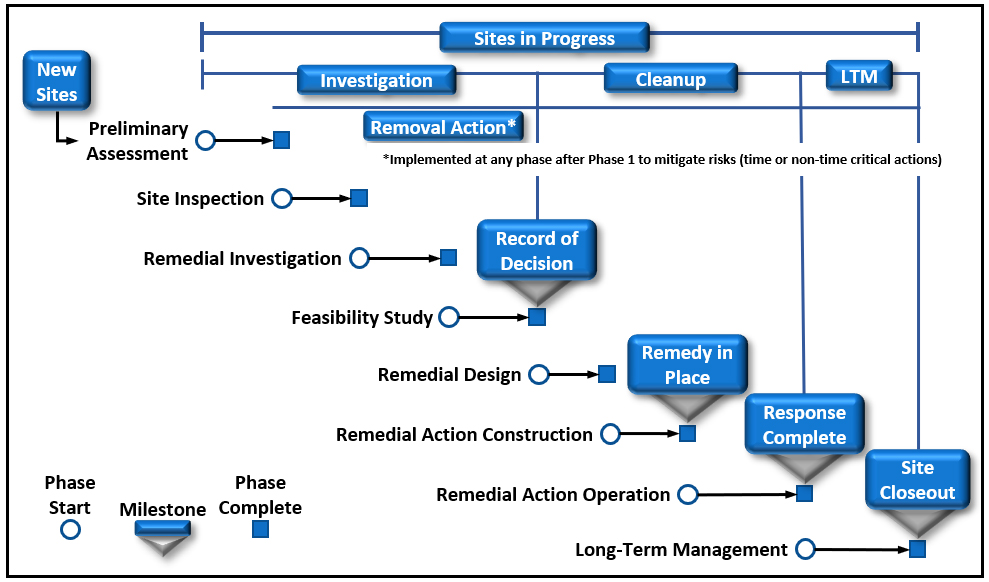Overview
The Department of the Navy (DON) Environmental Restoration Program (ERP) follows a multi-phase cleanup process that has several key milestones along the path to site closure. The process was established by the Comprehensive Environmental Response, Compensation, and Liability Act (CERCLA) and its implementing regulation, the National Contingency Plan (NCP) .
Process
The DON ERP process starts with the identification and investigation of contaminated sites, followed by selection, design, and implementation of remedial actions to achieve remediation goals. To ensure protectiveness, long-term management may be required at sites where conditions do not allow for unrestricted use. Review the phases and milestones shown here to learn more and access helpful resources on the Web pages linked below.

Phases and Milestones:
Preliminary Assessment/Site Inspection (PA/SI) Phase: This phase identifies contaminated sites based mostly on the review of existing information about hazardous waste disposal practices to determine if a release is known or suspected to have occurred. Limited field data may be collected. Available data may be compared to risk-based benchmarks to define chemicals of potential concern (COPCs). If the site does not pose an unacceptable risk to human health or the environment, it will be designated as requiring no further action (NFA). Otherwise, a removal action may be conducted and/or the site moves on to the next phase.
Remedial Investigation/Feasibility Study (RI/FS) Phase: The RI includes a sampling and analysis program that is adequate to determine the nature and extent of contamination, a baseline ecological risk assessment (BERA), and a human health risk assessment (HHRA). If cleanup is necessary, the FS is conducted and includes initial screening and then detailed evaluation of remediation alternatives. The RI or FS also may recommend NFA for the site.
Removal Action (RA) Phase: A removal action is a response implemented in an expedited manner to address contamination that poses a threat to human health and the environment. Removal actions can occur during any phase of the cleanup process.
Remedy Selection [Record of Decision (ROD)/Decision Document (DD) Milestone]: Following the RI/FS, the preferred alternative is documented in a Proposed Plan (PP) for public comments and all required remedial actions are documented in the ROD/DD. The ROD/DD includes a summary of the nature and extent of contamination and associated risks and/or hazards, selected remedy, remedial action objectives (RAOs), the rationale for selecting the remedy, and an exit strategy. For non-NPL sites, a DD may be prepared in place of a ROD, but with the state as the lead regulatory agency.
Remedial Design (RD)/Remedial Action Construction (RA-C) Phase: The RD phase involves preparing the detailed design of the remedial action selected in the ROD/DD. The remediation system is then constructed at the site. The RA-C phase also may include any construction related to implementation of land use controls (LUCs).
Remedy in Place (RIP) Milestone: This milestone is achieved when the construction of a long-term remedy is complete and the remedy is operating as planned to meet project RAOs in the future, or a short-term remedy has been successfully implemented and the final documentation is being prepared. Determination of achieving the RIP milestone is a DON decision and regulatory concurrence for this milestone is not required.
Remedial Action Operation (RA-O) Phase: This phase involves operation and maintenance (O&M) and monitoring actions. The RA-O phase may also include LUC implementation. Periodic monitoring reports are prepared during this phase to document performance of remediation systems.
Response Complete (RC) Milestone: This milestone is achieved when all cleanup goals specified in the ROD/DD are complete. For remedies requiring RA-O, this milestone indicates completion of the RA-O phase.
Long-Term Management (LTMgt): For sites reaching RC or with cleanup goals that do not allow for unrestricted use, monitoring may be required to determine the long-term protectiveness of the remedy. Actions may involve groundwater monitoring, implementation and management of LUCs, and preparation of five-year review reports.
Site Closeout (SC) Milestone: This milestone signifies that DON has completed active management and monitoring at a site, the remedy is protective of human health and the environment, contaminant levels at the site allow for unlimited use and unrestricted exposure (UU/UE), and there is no expectation of expending additional ER,N or BRAC funds at the site. The SC milestone can occur at any stage during the response action.